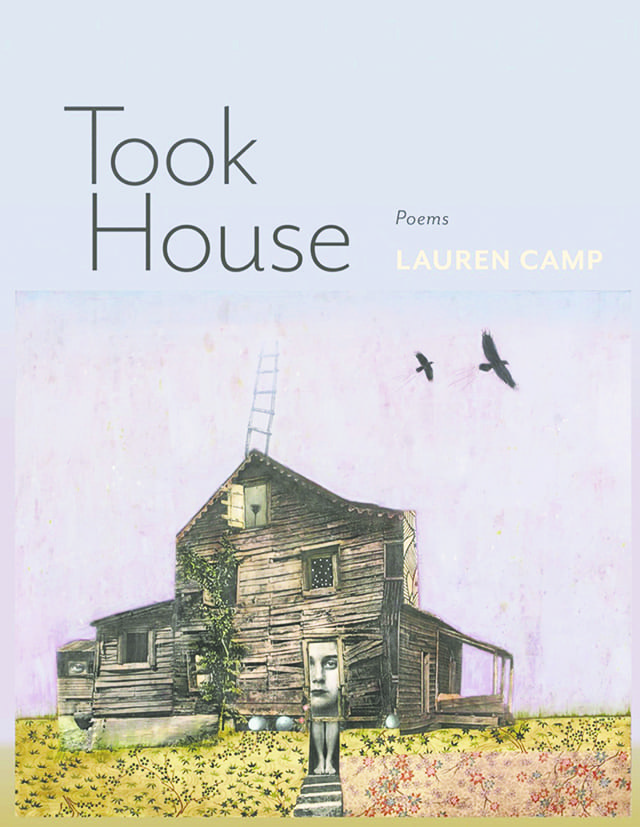
Lauren Camp was recently mentioned in an article published by Frontier Poetry. Lauren takes readers through her process of creating her most recent collection, Took House.
What were the most joyful moments of Took House’s journey to publication?
I began the poems that became Took House in 2005. My decisions about what would be included in the book shifted a great deal over nearly a dozen years. Meanwhile, I continued to revise individual poems. I didn’t mind all those variations and the chances to heighten the images and interior spaces—in fact, I sort of welcomed the flux and each new vantage point I brought when I returned to the manuscript.
I was very lucky that Tupelo Press accepted the manuscript when I felt it was done. And at that point, I stopped all work on the poems and the arrangement of them. Finally.
Perhaps the most joyous moment was finding the cover art—a mixed media piece by Albuquerque artist Suzanne Sbarge. I have long appreciated how Suzanne’s works encourage mystery and strange connections. This particular piece gave vision to precisely the symbols and situations I felt I had written. It is the perfect entry into the book!
What did you learn about writing and poetry over the journey of this book?
I repeatedly learn that my writing improves with periodic attentions. Perhaps other people draft their poems quickly and they’re done. That rarely works for me. I want to be a bit confounded by where a poem is going—and why. It’s a kind of pleasurable torture to have to wait for a poem to finish, to see it veer from the most likely path and obvious conclusion I have for it.
Specifically with Took House, I learned that if I give myself enough time to move away from the instigating kernels that start poems, and think other thoughts and get caught up in some of life’s other activities, when I return I bring a greater depth to the poems.
What was the favorite piece of media or art you consumed while writing these poems? (and how did it inform your writing?)
Took House let me indulge my fascination with a few eras of art. I came to poetry from a career as a visual artist, and the lens through which I read is so deeply influenced by how I experience (and how I made) art.
The longest poem in Took House considers Donald Judd’s 100 mill aluminum boxes in Marfa, Texas. Judd’s work seems empty—only it isn’t. There’s lots of space for the viewer (and for the poet) to metaphorically fit inside. I began the ekphrastic piece after a pilgrimage to see Judd’s boxes. The poem expanded as I figured out what I was trying to contain—or let go of.
It was equally thrilling to turn to one of Robert Rauschenberg’s very vibrant, contemporary artworks. All of Rauschenberg’s work reminds me that a multiplicity of images can be put together, and the viewer will make connections. This is a useful technique in writing, one that constructs wide poems. Such poems require metaphors and threads to connect the disparate parts. In Took House, I had one core story, but wanted also to move beyond it. I pushed the raptor poems and poems of visual art into the manuscript and set about building a collaged whole through that variety of angles.
I know you asked for one favorite piece, but I never work that way. I put a lot of influences into my mind and heart and see what shakes out. The residue of what has impacted me remains and is layered into the final drafts.
There’s a different type of structure I also consider and consume: jazz music. Thelonious Monk’s music, for example, teaches me about the weight silence can occupy in a piece. Bassist Charles Mingus reminds me to move from beauty to uncomfortable energy, not to stay static.
How has the pandemic altered the debut process of this collection? Any unexpected loss or joy?
As with many writers, all the events I had set up were canceled. I had plans to be in several other regions of the country, and all of those plans were suddenly flattened. What I found instead was the strength of a virtual community. On the release day for Took House, I felt a lofting up by fellow poets and editors, and these many kindnesses have continued in magical ways. It’s been heartening to participate in readings and interviews. In some ways, it seems possible that this distressing time allows books and authors to connect with more people; the reach is vast. I can have audience members from outside the U.S. at my events, people who don’t have to travel – just open a tab and listen.
What’s your one sentence piece of advice for poets currently putting a collection together?
Patience, more patience, effort, linguistic attention, and more patience.

